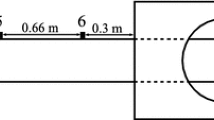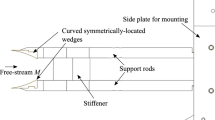Abstract
The interaction of a plane shock wave in air with concave profiles has been used in the past mainly to understand the nature of shock wave focusing. The current study examines the complex two-dimensional flow field resulting from the interaction of a plane shock wave entering a symmetrical cavity with curved walls. Of particular interest are the development of reflection patterns of the incident shock wave at the profile wall and the process of gas dynamic focus. These principal flow features are examined across a wide range of different reflector shapes. This includes a review of previously studied profiles such as cylindrical and parabolic, and also of a number of additional profiles, including compound profiles, where an inlet profile merging with that of the main cavity is shown to have major effects on the focusing mechanism and pressures. The various reflector shapes were specified by varying the shape of the profile and the depth-to-aperture ratio. The strength of the incident plane shock wave was limited between Mach numbers of 1.04 and 1.45. The principal flow features were established and examined experimentally using a variety of qualitative and quantitative flow visualization techniques, supplemented with numerical results. Time-resolved high-speed imaging was used to capture the interaction providing the unique ability to track the various transient flow features over the course of the interaction. The three primary factors that influence the maximum pressure amplification at focus, and the focus mechanism, are the incident shock strength, the depth-to-aperture ratio of the profile and an inlet profile leading into the main cavity, if present. An inlet profile results in higher-pressure amplifications for corresponding shock strengths and depth-to-aperture ratios. Increases in the depth-to-aperture ratio increase the maximum pressure amplification observed at focus. This occurs due to a combination of factors including: the strengthening of the individual shock waves involved in focus; the duration of focus; and the strengthening of a compressive flow field that develops adjacent to the shock system during focus. The compressive flow field adjacent to the shock system at focus is shown to be of great importance to the focus process.
Graphic abstract



















































Similar content being viewed by others
References
Apazidis N, Eliasson V (2019) Shock focusing phenomena. Springer, Berlin
Apazidis N, Kjellander M, Tillmark N (2012) High Energy concentration by symmetric shock focusing. In: Kontis K (ed) 28th International symposium on shock waves. Springer, Berlin
Babinsky H, Onodera O, Takayama K, Saito T, Voinovich P, Timofeev E (1998) The influence of entrance geometry of circular reflectors on shock wave focusing. Comput Fluids 27:611–618
Barth TJ, Jesperson DC (1989) The design and application of upwind schemes on unstructured meshes. AIAA paper. 89–0366
Ben-Dor G (2007) Shock wave reflection phenomena, 2nd edn. Springer, Berlin
Ben-Dor G, Takayama K (1986–87) The dynamics of the transition from Mach to regular reflection over concave cylinders. Israel J Tech 23:71–74
Bond C, Hill DJ, Meiron DI, Dimotakis PE (2009) Shock focusing in a planar convergent geometry: experiment and simulation. J Fluid Mech 641:297–333
Cates J, Sturtevant B (1987) Shock wave focusing using geometrical shock dynamics. Phys Fluids 9(30):3068
Dennen RS, Wilson LN (1962) Electrical generation of imploding shock waves. In: Chace WG, Moore HK (eds) Exploding wires. Plenum Press, New York, pp 145–157
Grönig H (1986) Shock wave focusing phenomena. In: Shock waves and shock tubes, 15th International symposium, Berkeley. Stanford University Press, pp 43–56
Gruber S, Skews B (2013) Weak shock wave reflection from concave surfaces. Exp Fluids 54:1571
Guderley G (1941) Starke kugelige und zylindrische Verdichtungsstöße in der Nähe des Kugelmittelpunktes bzw. der Zylinderachse. Luftfahrtforsch 29(9):302–312
Gustafsson G (1987) Experiments on shock-wave focusing in an elliptical cavity. J Appl Phys 61:5193–5195
Inoue O, Imuta G, Milton BE, Takayama K (1995) Computational study of shock wave focusing in a log-spiral duct. Shock Waves 5:183–188
Izumi K, Aso S, Nishida M (1994) Experimental and computational studies focusing processes of shock waves reflected from parabolic reflectors. Shock Waves 3:213–222
Kim H-D, Kweon Y-H, Setoguchi T, Matsuo S (2003) A study on the focusing phenomenon of a weak shock wave. Proc Instn Mech Engrs 217:1209–1220
Kleine H (2001) Measurement techniques and diagnostics: flow visualization. In: Ben-Dor G, Igra O, Elperin T (eds) Handbook of shock waves, vol 1. Academic Press, San Diego, pp 685–738
Knystautas R, Lee B, Lee J (1969) Diagnostic experiment on converging detonations. Phys Fluids Suppl 1:165–168
Liang SM, Wu LN, Hsu RL (1999) Numerical investigation of axisymmetric shock wave focus over paraboloidal reflectors. Shock Waves 9:367–379
Liou M-S (1996) A sequel to AUSM: AUSM+. J Comput Phys 129:36–382
MacLucas DA (2012) Shock wave-induced flow features in concave profiles. Doctoral thesis, University of the Witwatersrand, South Africa
MacLucas DA, Skews BW, Kleine H (2015) High-speed imaging of shock wave focusing in concave profiles using shearing interferometry and direction-indicating colour schlieren. J Vis 18:521–529
Marchiano R, Coulouvrat F, Grenon R (2003) Numerical simulation of shock wave focusing at fold caustics, with application to sonic boom. J Acoust Soc Am 114(4):1758–1771
Nishida M (1989) Focusing of reflected shock waves. In: Proceedings of the international workshop on shock wave focusing, ed. Takayama, K. Shock Wave Research Center, Institute of Fluid Science, Tohoku University, Sendai, Japan, pp 141–153
Oertel H, Oertel H (1989) Optische Strömungsmeßtechnik. Karlsruhe, G. Braun
Perry RW, Kantrowitz A (1951) The production and stability of converging shock waves. J Appl Phys 22:878–886
Shadloo MS, Hadjadj A, Chaudhuri A (2014) On the onset of postshock flow instabilities over concave surfaces. Phys Fluids 26(7):076101
Skews BW, Kleine H (2009) Shock wave interactions with concave cavities. In: Hannemann K, Seiler F (eds) 26th International symposium of shock waves. Springer, pp 1485–1490
Skews BW, Kleine H, Barber T, Iannucelli M (2007) New flow features in a cavity during shock wave impact. 16th Australasian fluid mechanics conference, Gold Coast, Australia
Skews BW, Kleine H (2007) Flow features resulting from shock wave impact on a cylindrical cavity. J Fluid Mech 580:481–493
Skews BW, Kleine H (2009) Unsteady flow diagnostics using weak perturbations. Exp Fluids 46:65–76
Sturtevant B (1989) The physics of shock focusing in the context of ESWL. In: Proceedings of the international workshop on shock wave focusing, ed. Takayama, K. Shock Wave Research Center, Institute of Fluid Science, Tohoku University, Sendai, Japan, pp 39–64. Sendai
Sturtevant B, Kulkarny VA (1976) The focusing of weak shock waves. J Fluid Mech 76:651–671
Taieb D, Ribert G, Hadjadj A (2010) Numerical simulations of shock focusing over concave surfaces. AIAA J 48(8):1739–1747
Takayama K (2019) Visualization of shock wave phenomena. Springer, Berlin. https://doi.org/10.1007/978-3-030-19451-2
Acknowledgements
The authors also wish to thank both the South African National Research Foundation for the KIC travel grant and the project Fluxion for their financial support during the first author’s postgraduate studies. The first author is also in deep gratitude to the CSIR for providing the time necessary to complete this work.
Author information
Authors and Affiliations
Corresponding author
Additional information
Publisher's Note
Springer Nature remains neutral with regard to jurisdictional claims in published maps and institutional affiliations.
Electronic supplementary material
Below is the link to the electronic supplementary material.
Supplementary material 1 (avi 2647 KB)
Supplementary material 2 (avi 1282 KB)
Supplementary material 3 (avi 1274 KB)
Supplementary material 4 (avi 3249 KB)
Rights and permissions
About this article
Cite this article
MacLucas, D., Skews, B. & Kleine, H. Shock wave interactions within concave cavities. Exp Fluids 61, 88 (2020). https://doi.org/10.1007/s00348-020-2914-z
Received:
Revised:
Accepted:
Published:
DOI: https://doi.org/10.1007/s00348-020-2914-z




